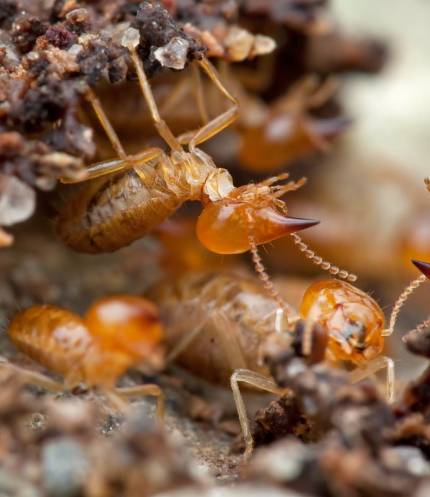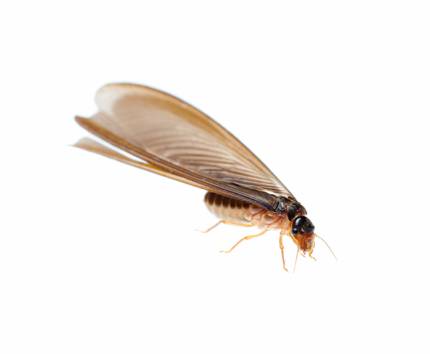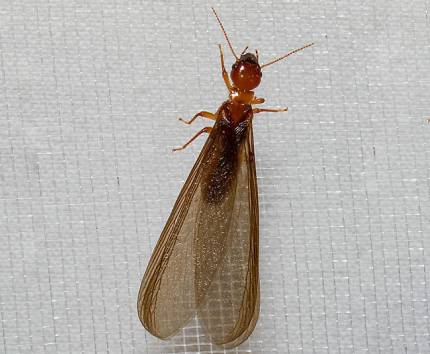Termite
Termite
Termites, are most commonly known as “White ants”. These are social insects living in a colony comprising a queen, king, workers and soldiers. The colonies of subterranean termites are located in the soil. Their basic food is anything containing cellulose, in search of food, they gain entry into the buildings. Each termite colony has millions of individual members. The tiny cream-coloured worker termites invade buildings and cause damage to structures often long before they are discovered. They consume and damage all types of wood, paper, hardboard, books, clothes etc.
In search of food, they also damage leather, rubber, electrical wire coatings, nylon, neoprene, thermocol, and practically everything man cherishes to own. They enter the buildings through foundation, expansion joints, lift wells, utility ducting such as electrical, and telephone cables or tunneling through cracks in the walls. They also construct mud tubes for their movement, which is the first sign of the presence of termites. They have the ability to travel long distances in search of food. It’s common to see termites on top floors of multistorey buildings.



Termites are particularly troublesome pests as they can cause serious damage to your home or workplace, and are notoriously difficult to get rid of. Often, they thrive discreetly and in inaccessible spots making termite control difficult. Do-It-Yourself anti-termite treatments like termite spray might not be able to treat termite infestation at the root level, especially in the case of large termite colonies. Getting termite treatment from an expert pest control brand is the best way to remove termites from your property and safeguard your precious belongings.
Subterranean Termites
Subterranean termites are the most common type of termites that infest homes. These termites need moisture to survive. They are closely associated with the soil, where they typically construct an underground nest or a series of interconnected nests, hence the name “subterranean termites.” Soil is a source of moisture that helps protect termites from the drying effects of air. It also shields termites from predators (ants, birds, etc.) that feed on them.
Subterranean termites excavate narrow tunnels through the soil, creating a network through which they can travel long distances to reach food. They also transport soil above ground to construct mud tubes and to line their feeding galleries in wood. Subterranean termites are social insects that live in nests or colonies in the soil. Termite colonies are organized into castes depending on tasks – workers, soldiers, and reproductive (swarmers).






Drywood Termites
Drywood termites are commonly found in wood with low moisture content. These termites do not require contact with soil moisture to live. They spend almost their entire life cycle inside the sound, dry wood upon which they feed. Since colonies are often small and found deep inside wood, they are difficult to detect. Colonies are also spread over a wide area.
Drywood termites also enter homes after swarms, usually occurring in the spring. An existing termite colony sends out many winged reproductive males and females during swarms. These mating swarms may result in several newly fertilized king and queen termites attempting to establish colonies, of which many may be within or around a home.
Damp wood Termite
Damp wood termite infests wood with high moisture content, creating tunnels while eating across the grain of the wood. Wood in contact with the ground or with a high moisture content is vulnerable to attack. Logs, stumps, dead trees, leaky pipes, or gutters can provide favourable conditions for this correcting these conditions conducive to infestation.



Truly Nolen’s Termite Pest Control service offers unparalleled protection, delivered by our skilled and experienced team. We use only CIB-approved chemicals to ensure safety and efficacy. Our process begins with drilling holes at the skirting level, spaced three feet apart, to target termite colonies. These holes are then filled with a potent chemical solution designed to destroy the colonies and create a comprehensive barrier across the ground. After the termite treatment, the holes are meticulously sealed with white cement and painted to match your wall colour, ensuring a seamless finish. This thorough approach guarantees long-lasting protection and utmost satisfaction. Trust Truly Nolen to safeguard your property from termite damage effectively with first-class pest control services.
Our Clients













Truly is present in more than 37 cities across the country, having more than 400 employees. TPS is currently serving 4000+ commercial and 10000+ residential clients, with an increasing list of clients on a daily basis.
- 915, Hemkunt Tower, 98 Nehru Place, New Delhi -110019.
© Truly Nolen 2023 . All Right Reserved. Designed By Verve Media.
